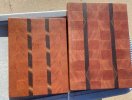- Joined
- Jan 19, 2013
- Messages
- 48
Hello!
I will be purchasing a fancy japanese kitchen knife and along with that I will be buying a new cutting board.
I found a local guy who makes custom end grain cutting boards. I was thinking about getting a 20"x15"x2" size. One side with a juice groove and other side flat.

Here's an example of his work. It looks pretty good to me. The only thing I'm concerned about is the fact that it's made out of walnut.
I don't know if that's too hard for a thin, high HRC japanese knife. He's also offering other types of wood but I don't know the pricing for those.
I would like a cutting board that will last me a while.
I'm open to your suggestions regarding the wood type, size and everything else.
Thanks!
I will be purchasing a fancy japanese kitchen knife and along with that I will be buying a new cutting board.
I found a local guy who makes custom end grain cutting boards. I was thinking about getting a 20"x15"x2" size. One side with a juice groove and other side flat.

Here's an example of his work. It looks pretty good to me. The only thing I'm concerned about is the fact that it's made out of walnut.
I don't know if that's too hard for a thin, high HRC japanese knife. He's also offering other types of wood but I don't know the pricing for those.
I would like a cutting board that will last me a while.
I'm open to your suggestions regarding the wood type, size and everything else.
Thanks!



